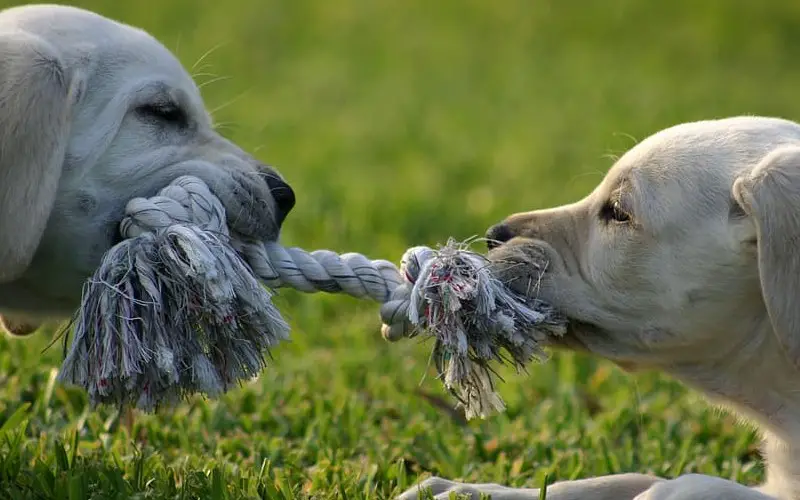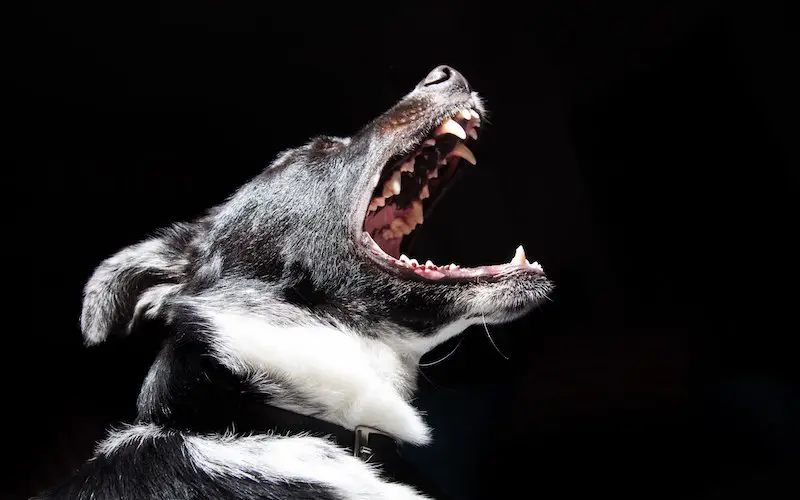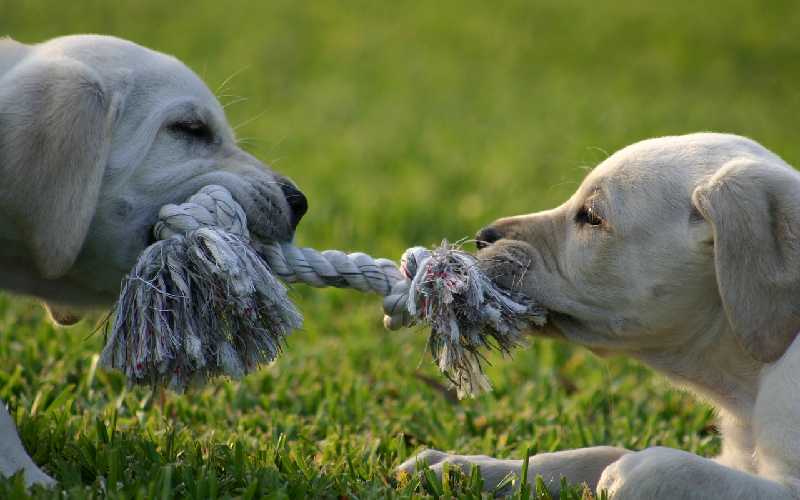Generally, dogs are not good at sharing. Dogs will fight over toys because they see toys as a valuable resource that is worth protecting from other dogs. You’ve probably experienced the situation when even though there are lots of dog toys around, but dog A wants the toy that dog B already has. Sometimes what we see as fighting is play, albeit noisy play as the dogs argue over a single toy. If your dogs are fighting over toys and one or other is getting hurt, when it’s a reoccurring problem, then your best option is to quickly get help from a respected dog trainer with experience of your breed or type of dogs.
Normal Play
It can be difficult for inexperienced owners or those not familiar with the situation to tell the difference between dogs playing, play fighting and real fighting. A lot of the time playing with toys is recreating true fighting or catching and killing something.

A typical normal play fighting situation is when two dogs have a tug of war with a toy; they are both growling and pulling. Even though the growls seem aggressive, they are playing, and both know it is just a game. This is the type of game that terriers in particular love and it is just play.
Another typical scenario is when dog A has a toy in their mouth and dog B chases them to try and steal the toy. Dog A holds on tight to the toy, growls and snarls showing their teeth. This is a warning to dog B that this toy is taken, keep away. This can be an innocent, fun game that the dogs play, and as long as both are playing by the same ‘rules’, they may even take it in turns to own and steal the toy. However, this is a game that can easily escalate into a fight when one dog values the toy more and doesn’t heed the warning from the other one. Usually, when it is a play situation, the dogs have a relaxed look about their body language; they may bow and jump around in a fun way. When real aggression is present, the body language is very different. Their bodies are stiffer, tails erect and the hairs along their back may be stood on end.
Ritualised Aggression
Something you have to learn when faced with dogs ‘fighting’ over toys is the difference between a game, play fighting and real resource guarding behaviour. It is not always easy to differentiate between play, solving their conflict without hurting each other or real aggressive, meaning harm behaviour.

If you consider packs of dogs in the wild, they will do their best to solve conflict without real harm because even a slight injury could be very costly to one or other of the dogs. The dynamic of a pack is essential for the survival of the members. They, therefore, learn to use ritualised aggression for conflict solving.
Our dogs have evolved and are far removed from wild packs, but they will mostly still have the instinct to avoid harmful conflict with each other whenever possible. The instinct starts with the mother and their litter brothers and sisters. We then foster this instinct when we socialise puppies. A well socialised dog will learn from its piers that real conflict with other dogs is not acceptable and what the different nuances of actions mean regarding toys, play and so on. Socialisation is an important part of educating and raising a well rounded dog.
Resource Guarding
There are still times that, despite being well socialised and mindfully brought up that some dogs consistently resource guard toys. It is something that can escalate when a new dog or visiting dog is introduced to the home, or you may see it even with dogs who live together and otherwise get on well.
Sometimes new toys can appear to create a problem. These new toys are highly prized because they are new and therefore very exciting and valuable. Although, there are also dogs who will be aggressive regarding old toys and their favourites in particular.
You will observe the signs of resource guarding toys when a dog has possession of a toy and another dog approaches them or when two dogs are both going to pick up the same toy. When you have a dog who is really resource guarding toys, it is something that you really want to deal with as soon as you know it is a genuine problem.
Occasional minor altercations probably need careful supervision and logging to ensure that the problem does not escalate or increase. Whether to intervene or not is also a tough decision to make and how to break up two dogs if a full-blown fight has kicked off. Distraction techniques frequently don’t work once the red mist has come down. If you notice that two dogs in your household have started to fight frequently and they are injuring each other, then the help of a well qualified behaviourist is required.
If you have any doubts about the way your dogs are with each other around toys, then it is worth considering getting a professional along to observe the behaviour and to hopefully put your mind at rest.
Avoiding Conflict
Because most dogs can’t actually bite when they have a toy in their mouth, the conflict over toys may be solved by quick distraction and offering dog B a similar toy and, importantly, your attention which is also a priced resource. One of the best ways to avoid conflict is to always ensure that when new toys are introduced that there are enough for each dog in the household. Some experienced owners always make sure that there is at least one spare toy over the number of dogs in the household.
Always supervise the dogs when they have access to free play with toys.
If you believe that there is real aggression and resource guarding of toys, then separate the dogs when they have access to toys until they have completed a course with the trainer/behaviourist.
If you consider that the resource guarding is mild, then have distraction techniques in place to prevent escalation of a game into a fight.
If you enjoyed this article you might also like to read about Dog Tug Toy for Terriers

